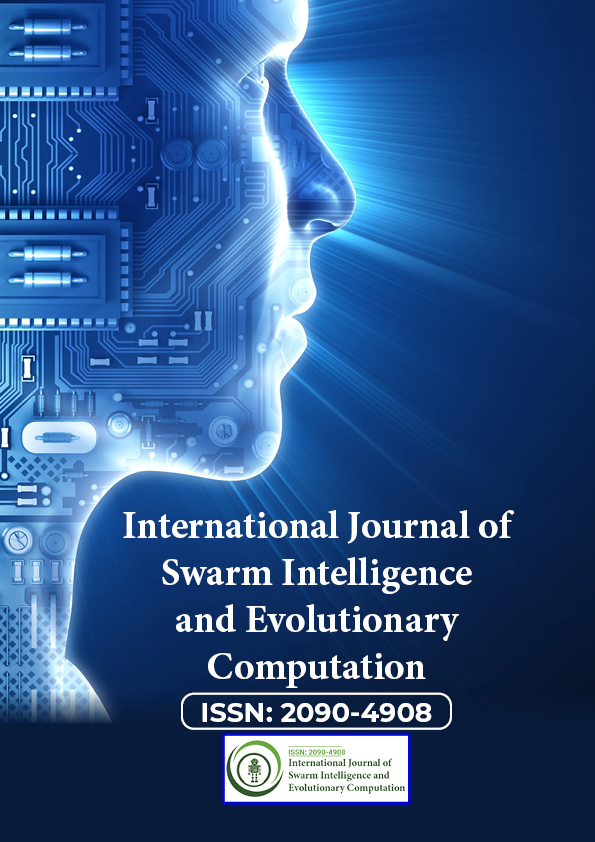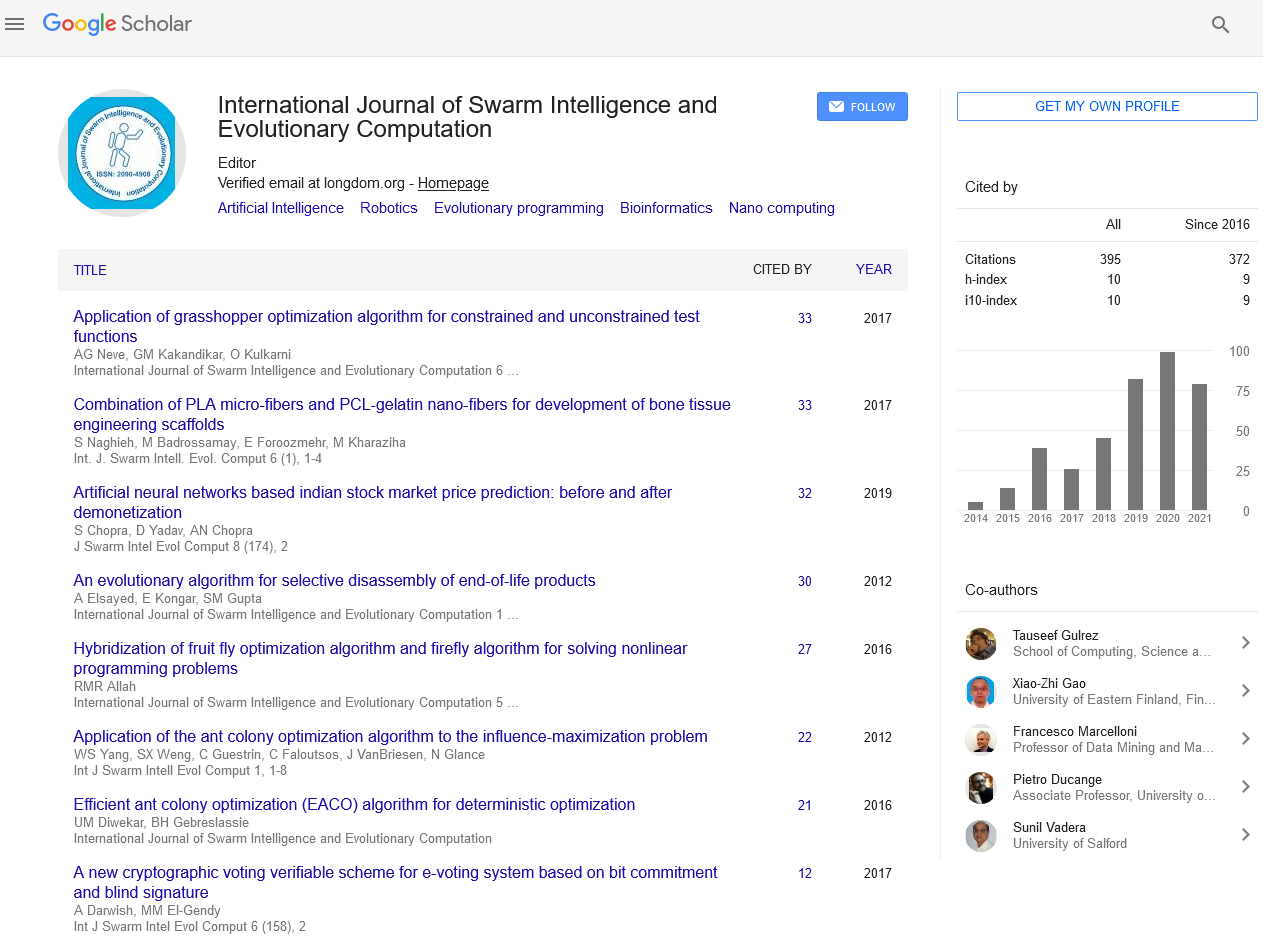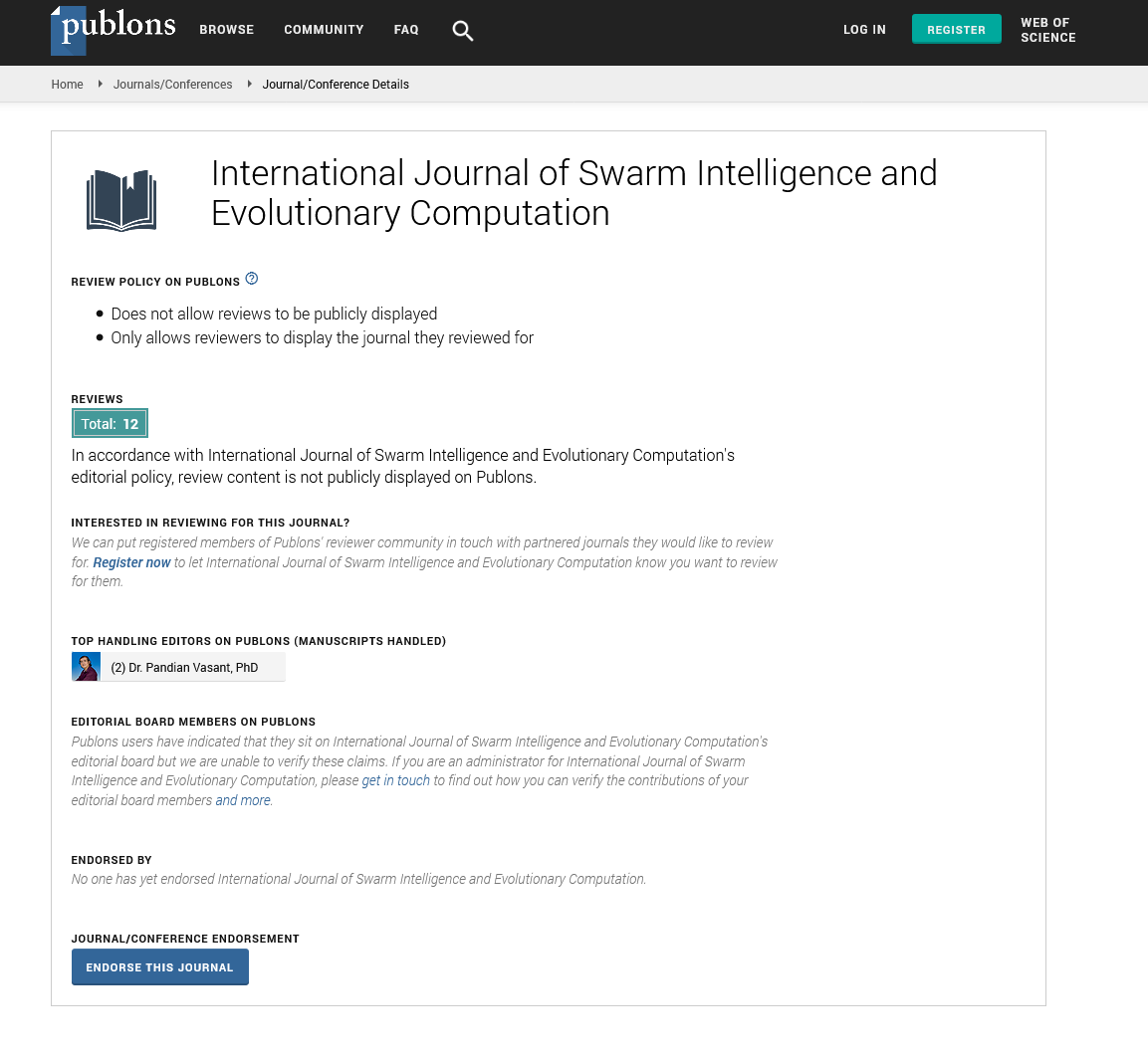Indexed In
- Genamics JournalSeek
- RefSeek
- Hamdard University
- EBSCO A-Z
- OCLC- WorldCat
- Publons
- Euro Pub
- Google Scholar
Useful Links
Share This Page
Journal Flyer

Open Access Journals
- Agri and Aquaculture
- Biochemistry
- Bioinformatics & Systems Biology
- Business & Management
- Chemistry
- Clinical Sciences
- Engineering
- Food & Nutrition
- General Science
- Genetics & Molecular Biology
- Immunology & Microbiology
- Medical Sciences
- Neuroscience & Psychology
- Nursing & Health Care
- Pharmaceutical Sciences
Perspective - (2024) Volume 13, Issue 5
Improving Machine Learning Algorithms with Swarm Intelligence
Giada Cimino*Received: 26-Aug-2024, Manuscript No. SIEC-24-27452; Editor assigned: 28-Aug-2024, Pre QC No. SIEC-24-27452 (PQ); Reviewed: 11-Sep-2024, QC No. SIEC-24-27452; Revised: 18-Sep-2024, Manuscript No. SIEC-24-27452 (R); Published: 25-Sep-2024, DOI: 10.35248/2090-4908.24.13.389
Description
Swarm intelligence is an exciting and rapidly evolving field within artificial intelligence that draws inspiration from the collective behavior of decentralized systems found in nature. These systems can be observed in various natural phenomena, such as the coordinated movements of bird flocks, the schooling patterns of fish, or the foraging behavior of ant colonies. These behaviors, despite the lack of centralized control, allow individual agents (birds, fish and ants) to collaborate in a way that leads to the emergence of intelligent global behaviors. This concept has become a valuable tool in solving complex optimization problems and improving the performance of Machine Learning (ML) algorithms.
Machine learning optimization
In the context of machine learning, optimization plays an important role in various stages of model development, including training, hyperparameter tuning and feature selection. Optimization helps to adjust the internal parameters of models so that they can make accurate predictions. However, traditional optimization methods like gradient descent have some limitations. For instance, gradient descent can sometimes become trapped in local minima, causing the algorithm to converge to suboptimal solutions. Additionally, traditional methods often require significant computational power, especially when the problem space is large. This is where swarm intelligence can offer a significant advantage, providing a more efficient and robust alternative.
Swarm intelligence-based optimization algorithms are capable of mimicking natural processes to examine the solution space more intelligently. These algorithms control the collective knowledge and behavior of multiple agents to search for optimal solutions in parallel, making them more effective in finding global optima, even in large, complex problem spaces.
Applications of swarm intelligence in machine learning
One of the most well-known swarm intelligence algorithms is Particle Swarm Optimization (PSO). PSO is inspired by the social behavior of birds flocking or fish schooling, where each "particle" in the swarm represents a potential solution to an optimization problem. The particles move through the solution space, adjusting their positions based on two factors: Their own past experience (best position) and the experiences of neighboring particles (global best position). This cooperative process helps the particles converge towards the optimal solution while avoiding local minima.
PSO has been successfully incorporated into machine learning to optimize the weights and parameters of various models, particularly neural networks. By using PSO for training neural networks, it is possible to adjust the weights more efficiently, which can lead to faster convergence and better generalization. Additionally, PSO can be applied to hyperparameter tuning, a difficult task in machine learning that involves selecting the optimal configuration for algorithms like decision trees, Support Vector Machines (SVM) and deep learning models. Since PSO explores the parameter space intelligently and avoids the pitfalls of local minima, it reduces the risk of overfitting, helping the model perform better on unseen data.
Another prominent swarm intelligence method is Ant Colony Optimization (ACO), which is based on the foraging behavior of ants. When ants search for food, they lay down a pheromone trail that guides other ants towards the food source. Over time, the trail that leads to the best food source becomes stronger, while less optimal paths are ignored. This process allows the ants to find the optimal route in an efficient manner. ACO has been successfully applied to various optimization problems, including feature selection and combinatorial optimization.
For example, in feature selection, ACO can be used to identify the most relevant features in a dataset. By selecting the best subset of features, ACO can significantly improve the accuracy of a machine learning model while also reducing the computational cost associated with training models on high-dimensional data. This ability to efficiently handle feature selection is particularly valuable in high-dimensional data scenarios, such as bioinformatics and image processing, where the number of features can be immense.
Swarm intelligence techniques are also gaining traction in ensemble learning, a machine learning model that involves training multiple models and combining their predictions to improve accuracy and robustness. Swarm-based optimization can be used to select the most diverse and complementary models in an ensemble. By doing so, the resulting ensemble is more likely to make accurate predictions, as the strengths of individual models are applied and weaknesses are mitigated.
The application of swarm intelligence in ensemble learning is particularly valuable in scenarios where the data is noisy, unbalanced, or contains outliers. In such cases, individual models might perform poorly, but a well-chosen ensemble of models, optimized using swarm intelligence, can provide a more reliable and robust solution.
Swarm intelligence techniques offer powerful tools for enhancing machine learning algorithms. By simulating the collaborative behavior of decentralized agents in nature, swarmbased algorithms such as PSO and ACO provide efficient optimization methods that improve model training, hyperparameter tuning, feature selection and ensemble learning. These techniques not only make optimization more efficient but also reduce the computational burden and yield better results across a wide range of applications. As machine learning continues to evolve, the integration of swarm intelligence will undoubtedly play an increasingly important role in tackling complex challenges and improving the overall performance of machine learning systems.
Citation: Cimino G (2024). Improving Machine Learning Algorithms with Swarm Intelligence. Int J Swarm Evol Comput. 13:389.
Copyright: © 2024 Cimino G. This is an open-access article distributed under the terms of the Creative Commons Attribution License, which permits unrestricted use, distribution and reproduction in any medium, provided the original author and source are credited.


